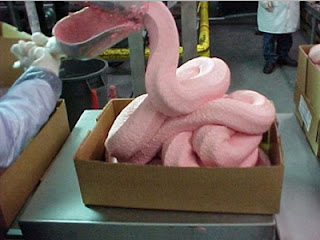Please
don't read this post if your hungry right now because you won't feel
same after reading these mind blowing creepiest facts about your day
today fast food.
HERE WE GO WITH OUR HUNGER KILLING FACTS.
1.THE AVERAGE FAST FOOD PATRON EATS 12 PUBIC HAIRS IN A GIVEN YEAR.
"we all get rare occasional hair in our food but Ingesting unwanted hair is more likely to occur at fast food restaurants."
2.A STRAWBERRY MCDONALD'S MILK SHAKE CONTAINS 50 ARTIFICIAL FLAVORS
"Apparently,
real strawberries are expensive. So fast food companies like McDonald's
choose to use a ridiculous concoction of 50 chemicals to effectively
imitate the flavor of one real-world food. These chemicals include ethyl
acetate, phenythyl alcohol and solvent."
3.THIS IS WHERE CHICKEN NUGGETS COME FROM.(updated on 28 december 2012)
"Before
reshaping, foods like chicken nuggets, hot dogs, bologna and pepperoni
look like a disgusting sludge of pink paste. This is done through a
process called mechanical separation, which is a cost-effective way to
"smooth out" bone remnants left after the de-boning process. The process
results in excessive bacteria, which is fixed by washing the meat in
ammonia. To cover up that delicious ammonia flavor, the meat is then
re-flavored artificially and dyed to resemble to type of meat it once
was."
McDonald's Chicken McNuggets are typically offered as an example of a popular MSP-based food, since 2003 that product has been made with all white meat rather than MSP.(read more here)
4.THERE ARE BUGS AND RODENT HAIR IN YOUR PEANUT BUTTER.
"FDA
laws allow for an average of 30 insect fragments per 100 grams of
peanut butter. In that same half cup of peanut butter, you'll also find
at least one rodent hair (on average). Yum! Now that's good eating!"
5. SHELLAC IS AN IMPORTANT INGREDIENT IN JELLY BEANS.
"Shellac
is a type of finishing product that is typically used to improve the
shine of wood and furniture. However, it can also be used to improve the
shine of certain foods, such as jelly beans. Where does shellac come
from? Why, it's secreted by an insect in Thailand called the Kerria
Iacca of course!"
6.VARIOUS VIRUSES CAN BE FOUND ON PROCESSED LUNCH MEAT
"Food
production companies have long sought ways to combat unhealthy microbes
found on processed foods such as lunch meat and hot dogs. A few years
ago, the FDA approved the use of bacteriophages (a.k.a. viruses) that
help kill these dangerous microbes. So, basically, viruses are purposely
being added to your food to improve shelf life."
7.IF NOT FOR ONE INGREDIENT, DRINKING A CAN OF COKE WOULD MAKE YOU VOMIT.
"While
cocaine was long taken out of Coca-Cola long ago, the current formula
is still formulated to get you high. Each can of Coke contains 10
teaspoons of sugar. This is 100 percent of your recommended daily
intake. In normal circumstances, the extreme sweetness of this much
sugar would immediately cause you to vomit uncontrollably. However,
since all that sugar is addictive and keeps you coming back for more,
Coca-Cola adds phosphoric acid -– an ingredient that cuts the sweetness
to manageable levels."
8.FAST FOOD SALADS CONTAIN CHEMICALS USED IN ANTIFREEZE.
"Choosing
to "eat healthy" at a fast food restaurant isn't necessarily a good
idea. To prolong crispness, packaged salads are dusted with Propylene
Glycerol, a chemical commonly found in antifreeze. In its concentrated
form, the chemical has been known to cause eye and skin irritation"
9.CHICKEN MCNUGGETS CONTAIN BEEF.
"Many
fast food chicken items contain beef additives used to enhance flavor
and juke health stats. Chicken McNuggets, the Wendy's Grilled Chicken
Sandwich, and KFC Grilled Chicken Sandwich are a few examples. Check the
ingredients, and you'll see no sign of such atrocities. That's because
such beef additives are listed as "extract" or "essence.""
10.PROCESSED CHEESE IS LESS THAN 51 PERCENT CHEESE.
"A
more accurate name for Kraft Singles and other packaged cheeses is
"cheese-like substance." Any cheese product labeled as processed or
pasteurized includes additives, chemicals and flavorings that account
for up 49 percent of the total product. As a result, that cheap cheese
in your grocery store has just enough real cheese in it to allow
companies to call it cheese."
[Source]













